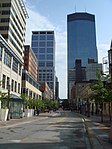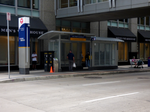RSM Plaza

RSM Plaza is a 320-foot (98 m) tall skyscraper in Minneapolis, Minnesota. Formerly known as McGladrey Plaza, it was completed in 1969 and has 20 floors. In October 2015, the building was renamed RSM Plaza after its largest tenant, McGladrey, changed its own name to RSM. It is the 30th-tallest building in the city and is located on Nicollet Mall. At the time of its completion, the building was the fifth-tallest structure in Minneapolis and the city's second-tallest post-World War II high-rise, behind Canadian Pacific Plaza. The building is skyway connected to The Metro Apartments, the Medical Arts Building and the IDS Center.The building was bought by GOLUB, an international real estate investment and development company, in December 2015. The structure has a floor area of 416,000 square feet (38,600 m2) and an 870-space parking ramp. Major tenants of the building include RSM, Clorox, Colgate-Palmolive, and Portico Benefits. RSM Plaza served as the home of the fictional WJM-TV station of The Mary Tyler Moore Show, an American sitcom that was broadcast on CBS from 1970 to 1977. The opening title sequence was filmed nearby on Nicollet Mall.
Excerpt from the Wikipedia article RSM Plaza (License: CC BY-SA 3.0, Authors, Images).RSM Plaza
Minneapolis Skyway, Minneapolis
Geographical coordinates (GPS) Address External links Nearby Places Show on map
Geographical coordinates (GPS)
| Latitude | Longitude |
|---|---|
| N 44.975555555556 ° | E -93.273055555556 ° |
Address
McGladrey Plaza
Minneapolis Skyway
55402 Minneapolis
Minnesota, United States
Open on Google Maps





